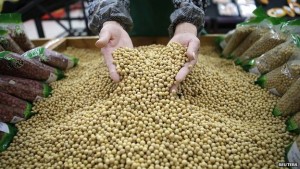 El Nino events can have a significant impact on the yields of certain major food crops, a study has shown.
El Nino events can have a significant impact on the yields of certain major food crops, a study has shown.
Researchers say the climatic phenomenon, which triggers changes in temperature and rainfall, can reduce maize yields by more than 4%.
El Nino episodes are caused by changes in the sea surface temperature in the eastern tropical Pacific Ocean.
Writing in Nature Communications, the team said the data could be used by governments to manage food supplies.
They wrote: “Results show that El Nino likely improves the global-mean soybean yield by 2.1-5.4% but appears to change the yields of maize, rice and wheat by -4.3% to 0.8%.
“The global-mean yield of all four crops during La Nina years tend to be below normal (-4.5% to 0.0%),” they observed.
The periodic warming (El Nino) and cooling (La Nina) of sea surface temperature in the eastern Pacific Ocean are phases in the naturally occurring phenomenon El Nino-Southern Oscillation (ENSO).
These phases cause a shift in the position of the jetstream, which – in turns – alters temperature and rainfall patterns in many regions around the world.
These changes result in extreme weather conditions, such as drought or abnormal rainfall, in the affected areas. This has a knock-on effect on crop yields, which are heavily influenced by temperature and precipitation levels.
Food forecasts
“This new work tells us that we can predict when the bad years will be, ahead of the harvest,” explain co-author Prof Andy Challinor from the University of Leeds, UK.
The researchers found that the high reliability of ENSO forecasts presented an opportunity to link it with global crop yields data.
This, in turn, would be potentially beneficial for food monitoring and famine early warning systems.
The team mapped the impact of ENSO on the yields of four major food crops: maize, rice, wheat and soybean.
These crops account for almost 60% of the world’s food calories produced on croplands.
The team observed: “Our results reveal that ENSO’s impacts on the yield vary among geographical locations, crop types, ENSO phase and technology used by the crop-producing regions.
“Consequently, minimising the negative impacts or maximising the positive impacts of ENSO on global yields are increasingly important not only to ensure short-term food availability but also to maintain positive yield trends.”
The scientists suggested that the forecasts could help mitigate impacts by influencing planting dates, crop choices, as well as considering other inputs such as chemical treatments and irrigation.
“An improved response to ENSO could reduce the risk of malnutrition; allow for an increase in agricultural investment in positively impacted years; and improve the adaptation capability to climate variability and change.”
Earlier this year, the UN World Meteorological Organization (WMO) predicted a warming of the tropical Pacific, with a majority of models indicating that an “El Nino may develop around the middle of the year”.
This week, data collected by Nasa satellites showed that conditions in the eastern Pacific at the beginning of May 2014 were similar to those experienced in May 1997 – a year that saw one of the powerful El Nino episodes in the 20th Century, which claimed an estimated 2,100 lives and caused US $33bn damage to properties.





